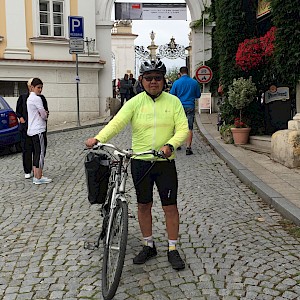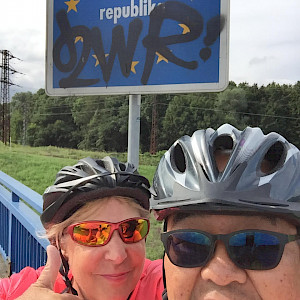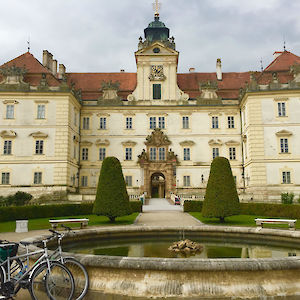Tripsite Traveler: Where on Earth is Moravia?
Looking forward to our 30th anniversary, I said to my wife, “Let’s take a trip and visit Poland.” Since she had been to my native Taiwan many times, I thought it only fitting to see the place where her ancestors came from—Poland.
We wondered, how many countries could we cover on a week-long bike trip? The Moravia bike tour would take us from Poland through Czech Republic, Slovakia, and into Austria. Great! Let’s book it--our first bicycling vacation, and it’s sure to be memorable.
But, where on Earth is Moravia? Whenever we mentioned that we would be biking through the Czech Republic, everyone suggested what to see and do in Prague. What about Moravia?
A pre-meeting dinner was held in a lovely hotel restaurant in Old Town Krakow. We were fortunate to sit with a couple from Canada who started vacationing-by-bicycle eight years ago. It was comforting to hear these veterans share their joys and mishaps. That evening, a set of maps was handed to us, and the following morning we were on our way.
Moravia turned out to be everything we looked forward to and more. This corridor is off the war-torn path of Eastern Europe; the buildings, the culture, and the land have been preserved beautifully. We learned that Napoleon traversed here on his way to defeat the Austrians, and it was there that he reached his military height. The Austrian Emperor met him under a lemon tree to surrender with Prince of Lichtenstein standing nearby. The Lichtenstein family ruled the region for 600 years and left many expansive buildings and sculptures tucked away in the forest. (This is an online version of booklet that explains more about the region and follows Napoleon’s steps )
The land is so fertile; everywhere we looked, it was cultivated. However, it would be a mistake to think that your eyes will be saturated only with corn fields. There are apple & peach trees, berry bushes, sunflower & lavender fields galore along the bike paths. We saw horse farms with young foals sunning themselves in grassy fields. There were managed forests providing shade for a sunny day and long stretches beside canals and river valleys. From time to time, passenger trains passed by with a friendly whistle. One day, it rained a lot. We gave it a good 10K of biking but then decided to hop on a local train, along with our bikes, and arrived at our day’s destination to dry out.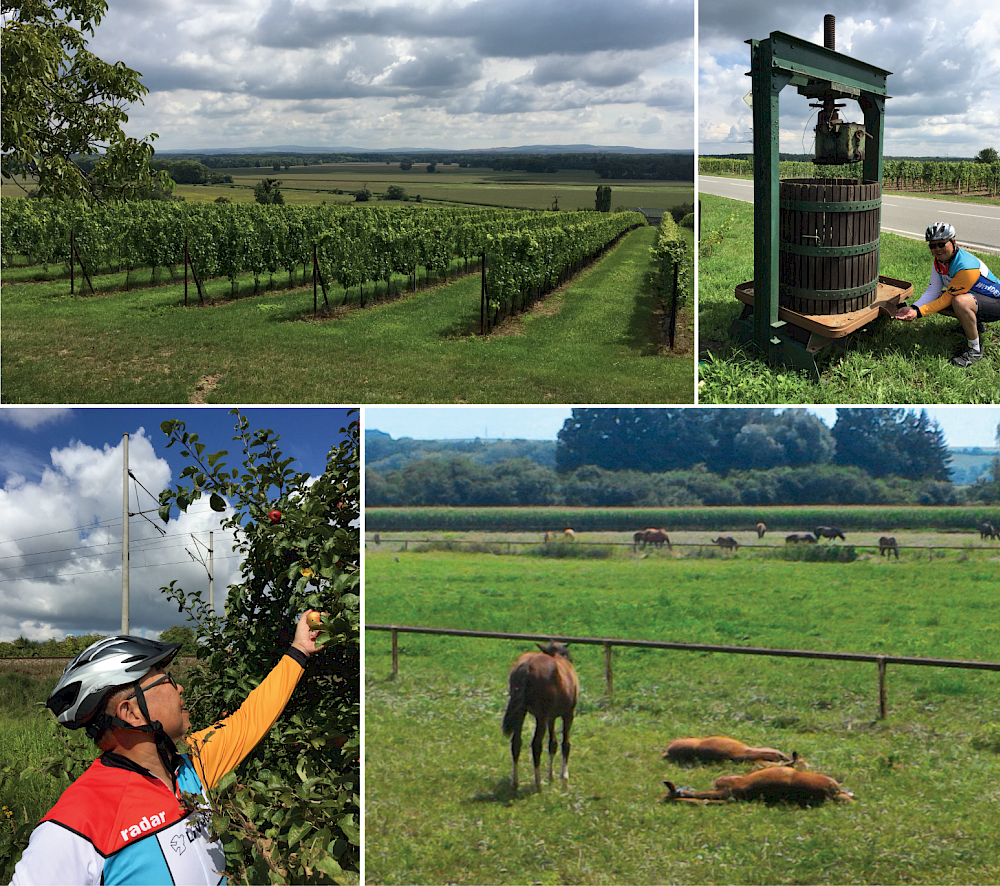

It was always exciting to see the distance marking go down on the sign posts as we approached each new town. We never knew what to expect; sometimes we traveled through small towns with only one intersection and bewildering side streets. The bike paths were usually so quiet. The soothing ride was almost like a pilgrimage to some distance shrine.
The destination towns had lively squares; some were better preserved or escaped industrialization. The city Olomouc appeared to be a major hub with a university and busy shopping area. Kromĕříž had a lovely town square with plenty of food choices. Off the town square was a magnificent archbishop residence and a well-kept garden/zoo. I even tried to fit into the guard station—just for fun.

Uherske Hradiste (impossible for my tongue to pronounce) offered a blend of shops and pubs and a very helpful visitor’s center. A magnificent cathedral was being renovated there, and a young guide led us through rooms which had fresco paintings depicting the story of its patron saint. We had a glimpse of a communist-era city in Hodonin. In Breclav, we were challenged to find our way out, but once we did, the ride through the forest afterward was truly magical. A local winemaker sold his wine by the glass (a real glass) to hikers and bicyclists.
Mikulov sat on top of a hill and was teaming with visitors on holiday. We took a wrong turn on the ascent but ended up in a quiet corner of the town and enjoyed a kosher lunch. It turned out Mikulov welcomed Sigmund Freud for many summers when he wanted to escape crowded Vienna.
The accommodations covered a wide spectrum of styles, but they were always fresh, clean and comfortable. We sampled quaint inns on the main square, family-style hotels, a communist-era concrete lodging house, and an 18th-century castle, converted into a modern-day hotel.
We didn’t know any Polish or Czech; however, the locals enthusiastically tried to help us whenever we asked. Be warned that many locals are not familiar with their own bike routes & route number designations.
One time we got lost and came across an old comrade just riding along in the field. So, without any language to help us understand, he decided to lead us back to the correct route. What a great guy; he biked so fast, we could hardly keep up with him. Here is a picture of us before we parted ways.
The bike route through Moravia varies from paved designated bike paths to shared farm tracks and everything in between. The farm tracks can vary from pleasant gravel paths to ones chewed up by the tractors. Among the designated bike paths through the woods, we encountered a few that required careful maneuvering to avoid mud puddles. Many had pub stops along the way for rest and refreshment.
Near the Czech and Austrian border (also known as the iron curtain route), there were a number of sites which detailed the communist-era escape route. We came across a somber memorial of iron beams with etched names of those who perished making the effort to cross the border. It is hard to believe that within a lifetime, the border has disappeared altogether, and we can fearlessly cross between countries. One advantage of traveling by bike is the chance to stop and take a photo at the EU border signpost then cross the street and take another picture.
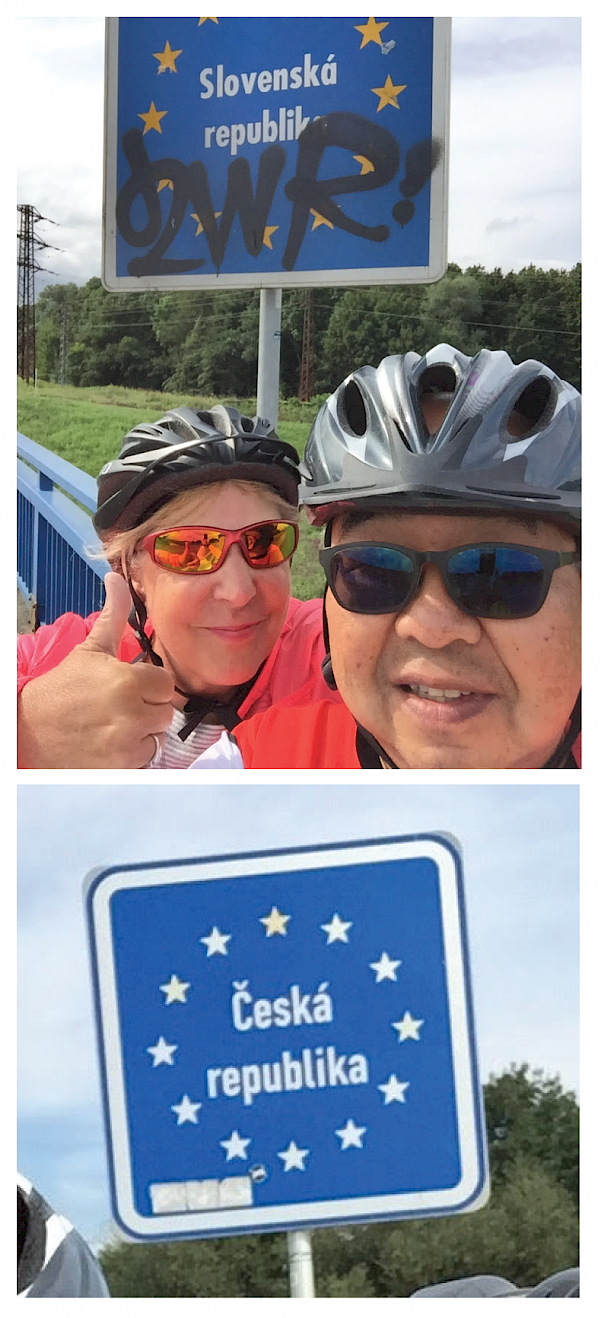
Ah, we have to mention the food. Nothing was spectacular, but everything was fresh and tasty. I am no potato lover, but the freshly harvested potato, in its ever-appetizing variety, made me a believer that there is more to the potato than what we are used to in the States. Beer and wine was plentiful, cheap and very good. After all, more than 90% of Czech wine comes from Moravia.
The trip through Moravia was perfect. We saw a part of Europe, but not the usual chic tourist sites associated with the metropolitan areas. We saw history preserved in its cobblestoned streets. We met earnest people who made us yearn for a common language.
Gallery
(Click to enlarge)
Feel free to explore other bike tours in Czech Republic, Poland, and Austria.
Comments
mike
7 years ago
Verified Reviewer









